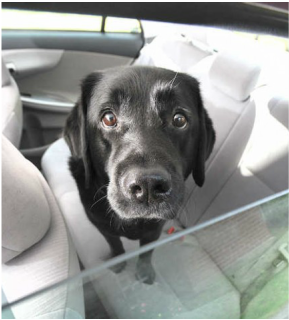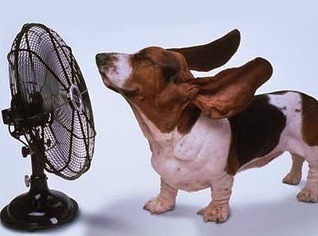| by Dr Lauren Walter It is the hot time of year again, and sadly, heat stroke (otherwise known as heat stress or exercise induced hyperthermia) is a real and potentially fatal risk to your pet. The most common heat stress situations occur when dogs are left in cars, worked in hot conditions, left unattended in yards with little shade, or when they knock their water over. There are even some dogs that are at increased risk of getting too hot. These are generally short-nosed breeds such as bulldogs and pugs, and those with underlying breathing difficulties. These dogs have problems because their main cooling method (ie. panting) is already compromised. And we also have to be careful of working dogs and mad ball chasers, which are very prone to heat stress if not given “rest breaks”. |
.It has been shown that on a 30’C day, the temperature in a parked car can reach 50’C in 5 minutes and over 70’C within 10 minutes! Leaving the windows ajar makes no difference to the temperature increase. Your dog’s normal temperature is between 38 and 39’C and they only have to reach 42’C to be at risk of dying.
Heat stroke is a very serious condition with many complications that requires aggressive intensive care. Unfortunately, many severely affected dogs do not recover.
Heat stroke is a very serious condition with many complications that requires aggressive intensive care. Unfortunately, many severely affected dogs do not recover.
| But what should we do if the worst happens? If you find your pet overheated, follow these simple guidelines to help maximize their chance of recovery: Do 1. Immediately wet them down with cool water (not cold). Repeat frequently!! Hosing gently under the neck and belly between the legs can be effective. |
2. Take them to the vet ASAP. Time is of the essence!!
3. Wet them down for the journey. Windows down, fans full blast and air conditioning on.
If you are unable to come in immediately,
1. Move your animal to a cool shaded area with good air flow or use a fan.
2. Wet down your animal. Place cool packs (or ice packs wrapped in towels) in armpits and groin areas.
3. If possible, Monitor their rectal temperature.
Regardless, you must stop actively cooling once temperature reduces to 39.5’C.
3. Wet them down for the journey. Windows down, fans full blast and air conditioning on.
If you are unable to come in immediately,
1. Move your animal to a cool shaded area with good air flow or use a fan.
2. Wet down your animal. Place cool packs (or ice packs wrapped in towels) in armpits and groin areas.
3. If possible, Monitor their rectal temperature.
Regardless, you must stop actively cooling once temperature reduces to 39.5’C.
Do NOT
1. Do NOT Immerse your dog in cold water or put them in ice baths.This reduces peripheral circulation, and whilst the extremities become cold, their vital internal organs stay hot! Animals that are over-cooled (become hypothermic) are much less likely to survive.
2. Do NOT Cut their ears. Dogs can survive despite this common procedure, but it does nothing to help them. It does not help to cool your dog at all!! In fact, the resultant blood loss can further reduce vital organ function and make things worse. Your pet is in a critical condition and may develop a bleeding disorder. More blood loss will not help!
3. Do NOT Cover them with towels, wet or otherwise. People often think this is the right thing to do. In fact, this can prevent proper convection cooling and actually trap the heat in.
So what should I do to help them in the future?
Do NOT Exercise dogs during the day in hot weather. Prevention is better than cure. In warm conditions, allow your pet to rest and cool every 30 minutes. Be particularly careful in humid weather as their normal panting (evaporative cooling) system is less effective. You cannot rely on them to tell you when they need a rest
Most importantly Do NOT Put a recovered dog in a risky situation again. There can be permanent damage to the ‘heat centre’ of the brain from an episode of heat stress. Recovered animals remain at a higher risk of developing hyperthermia and hyopothermia in the future.
For further questions or queries, contact our vets at Katherine Veterinary Clinic, or Alice Veterinary Centre.
1. Do NOT Immerse your dog in cold water or put them in ice baths.This reduces peripheral circulation, and whilst the extremities become cold, their vital internal organs stay hot! Animals that are over-cooled (become hypothermic) are much less likely to survive.
2. Do NOT Cut their ears. Dogs can survive despite this common procedure, but it does nothing to help them. It does not help to cool your dog at all!! In fact, the resultant blood loss can further reduce vital organ function and make things worse. Your pet is in a critical condition and may develop a bleeding disorder. More blood loss will not help!
3. Do NOT Cover them with towels, wet or otherwise. People often think this is the right thing to do. In fact, this can prevent proper convection cooling and actually trap the heat in.
So what should I do to help them in the future?
Do NOT Exercise dogs during the day in hot weather. Prevention is better than cure. In warm conditions, allow your pet to rest and cool every 30 minutes. Be particularly careful in humid weather as their normal panting (evaporative cooling) system is less effective. You cannot rely on them to tell you when they need a rest
Most importantly Do NOT Put a recovered dog in a risky situation again. There can be permanent damage to the ‘heat centre’ of the brain from an episode of heat stress. Recovered animals remain at a higher risk of developing hyperthermia and hyopothermia in the future.
For further questions or queries, contact our vets at Katherine Veterinary Clinic, or Alice Veterinary Centre.



 RSS Feed
RSS Feed